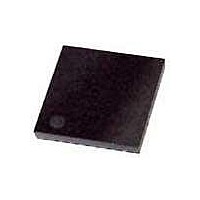WM9713LGEFL/RV Wolfson Microelectronics, WM9713LGEFL/RV Datasheet - Page 80

WM9713LGEFL/RV
Manufacturer Part Number
WM9713LGEFL/RV
Description
Audio CODECs Stereo AC'97 CODEC T/P Interface
Manufacturer
Wolfson Microelectronics
Datasheet
1.WM9713LGEFLRV.pdf
(132 pages)
Specifications of WM9713LGEFL/RV
Number Of Adc Inputs
1
Number Of Dac Outputs
1
Conversion Rate
8 KSPs
Interface Type
AC97
Resolution
12 bit
Maximum Operating Temperature
+ 85 C
Mounting Style
SMD/SMT
Package / Case
QFN-48
Minimum Operating Temperature
- 25 C
Number Of Channels
1 ADC, 1 DAC
Lead Free Status / RoHS Status
Lead free / RoHS Compliant
Available stocks
Company
Part Number
Manufacturer
Quantity
Price
Part Number:
WM9713LGEFL/RV
Manufacturer:
WOLFSON
Quantity:
20 000
WM9713L
BATTERY ALARM AND ANALOGUE COMPARATORS
w
The battery alarm function differs from battery measurement in that it does not actually measure the
battery voltage. Battery alarm only indicates “OK”, “Low” or “Dead”. The advantage of the battery
alarm function is that it does not require a clock and can therefore be used in low-power sleep or
standby modes.
Figure 33 Battery Alarm Example Schematic
The typical schematic for a dual threshold battery alarm is shown above. This alarm has two
thresholds, “dead battery” (COMP1) and “low battery” (COMP2). R1, R2 and R3 set the threshold
voltages. Their values can be up to about 1MΩ in order to keep the battery current [I
(R1+R2+R3)] to a minimum (higher resistor values may affect the accuracy of the system as leakage
currents into the input pins become significant).
Dead battery alarm: COMP1 triggers when V
A dead battery alarm is the highest priority of interrupt in the system. It should immediately save all
unsaved data and shut down the system. The GP15, GS15 and GW15 bits must be set to generate
this interrupt.
Low battery alarm: COMP2 triggers when V
A low battery alarm has a lower priority than a dead battery alarm. Since the threshold voltage is
higher than for a dead battery alarm, there is enough power left in the battery to give the user a
warning and/or shut down “gracefully”. When V
alarms are filtered out by the COMP2 delay function.
The purpose of the capacitor C is to remove from the comparator inputs any high frequency noise or
glitches that may be present on the battery (for example, noise generated by a charge pump). It
forms a low pass filter with R1, R2 and R3.
Low pass cutoff f
Provided that the cutoff frequency is several orders of magnitude lower than the noise frequency f
this simple circuit can achieve excellent noise rejection.
Noise rejection [dB] = 20 log (f
The circuit shown above also allows for measuring the battery voltage V
by setting the touchpanel ADC input to be either COMP1 (ADCSEL = 100) or COMP2 (ADCSEL =
101) (see also Auxiliary ADC Inputs).
c
[Hz] = 1/ (2π C × (R1 || (R2+R3)))
n
/ f
c
)
BATT
BATT
BATT
< VREF × (R1+R2+R3) / R3
< VREF × (R1+R2+R3) / (R2+R3)
gets close to the low battery threshold, spurious
BATT
PP Rev 3.2 September 2008
. This is achieved simply
ALARM
Pre-Production
= V
BATT
80
n
/
,













